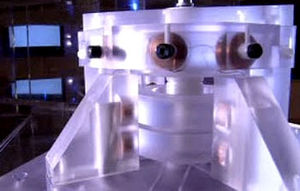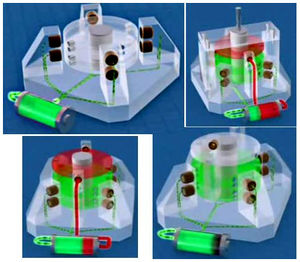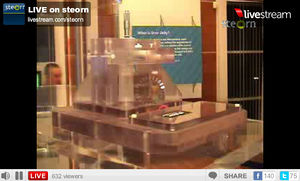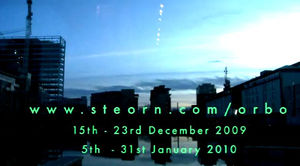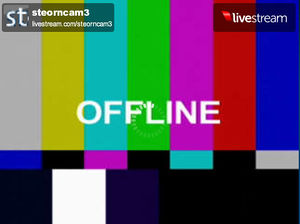Difference between revisions of "Steorn"
(Some fixes) |
|||
| Line 4: | Line 4: | ||
'''Steorn Ltd.''' is an Irish company based in Dublin claiming to have build a [[Perpetual Motion]] device called "Orbo" which, violating fundamental principles of physics, is supposed to create limitless energy. | '''Steorn Ltd.''' is an Irish company based in Dublin claiming to have build a [[Perpetual Motion]] device called "Orbo" which, violating fundamental principles of physics, is supposed to create limitless energy. | ||
| − | In August 2006 Steorn placed a large scale advertisement receiving wide attention in the English newspaper "The Economist"<ref>The Economist, August 19, 2006</ref> claiming to be able to provide "free, clean and constant energy". The scientific community was challenged to investigate the technology and report the findings to the world. According to the advertisement price list of the newspaper they spent about 125.000 Euro (£ 85.200) on that ad. | + | In August 2006 Steorn placed a large scale advertisement receiving wide attention in the English newspaper "The Economist"<ref>The Economist, August 19, 2006</ref> claiming to be able to provide "free, clean and constant energy". The scientific community was challenged to investigate the technology and report the findings to the world. According to the advertisement price list of the newspaper they spent about 125.000 Euro (£ 85.200) on that ad. Several tries to show a functioning Orbo-PM to the public failed. A group of scientists which were allowed to test the device could not find evidence that it could create "energy for nothing".<ref>[http://www.irishtimes.com/newspaper/ireland/2009/0624/1224249416758.html Irish 'energy for nothing' gizmo fails jury vetting], Irish Times Wed 06 Jun 2009</ref> |
| − | + | An allegedly working Orbo unit constructed of clear plastic was shown on 15. Dezember 2009 in Dublin (Waterways Centre Building) and a video stream of the running device published on the website. The claims of the company Steorn about the "Orbo"-Technology violate the first law of thermodynamics, that energy in an isolated system stays the same and can neither be destroyed nor created. It can only change forms. | |
| − | |||
| − | An allegedly working Orbo unit constructed of clear plastic was shown on 15. Dezember 2009 in Dublin (Waterways Centre Building) and a video stream of the running device published on the website. | ||
| − | |||
| − | The claims of the company Steorn about the "Orbo"-Technology violate the first law of thermodynamics, that energy in an isolated system stays the same and can neither be destroyed nor created. It can only change forms. | ||
==Orbo== | ==Orbo== | ||
| − | [[image:Orbo.jpg|Orbo-technology(Bild: | + | [[image:Orbo.jpg|Orbo-technology(Bild:Steorn-Video)|300px|thumb]] |
The wonder-technology from Steorn called "Steorn Orbo Technology" is based on a fictitious "time variant magneto-mechanical interaction" and said to be able to provide "clean energy" for mobile sound systems and cars. It is claimed to be a so called "overunity technology", which means that it can create more energy than it consumes. Orbo is a registered brand. | The wonder-technology from Steorn called "Steorn Orbo Technology" is based on a fictitious "time variant magneto-mechanical interaction" and said to be able to provide "clean energy" for mobile sound systems and cars. It is claimed to be a so called "overunity technology", which means that it can create more energy than it consumes. Orbo is a registered brand. | ||
Older publications of Steorn claimed that energy was created using time variant magnetic viscosity, an effect that only Steorn has understood. According to Steorn converging magnets fast uses less energy than pulling them apart slowly because the magnets would not have enough time to readjust their magnetic domains. | Older publications of Steorn claimed that energy was created using time variant magnetic viscosity, an effect that only Steorn has understood. According to Steorn converging magnets fast uses less energy than pulling them apart slowly because the magnets would not have enough time to readjust their magnetic domains. | ||
| − | + | The eOrbo device that was shown in Dublin is said to draw pulse-shaped electric current from a little battery and form it to a magnetic field using small inductors which affect the attraction of the rotating permanent magnets in the following ways: During convergence they maximize the attracting powers and during parting they minimize it. Such a "Broken Symmetry" hypothesis had been formulated by a Tom Bearden years before..<ref>http://www.cheniere.org/references/brokensymmetry.htm</ref> The right moment to pulse power is said to be determined by a Reed-Relay. The rotation of the magnets should induce current in conductors (according to Faraday's law of induction) which should after rectification charge the battery. The engine output is ostensibly higher than the consumption (''overunity'') and it is unnecessary to ever replace the battery. | |
| − | |||
| − | |||
==Demonstrations== | ==Demonstrations== | ||
[[image:Steorn Demo.jpg|thumb]] | [[image:Steorn Demo.jpg|thumb]] | ||
[[image:Steorn9.jpg|300px|thumb]] | [[image:Steorn9.jpg|300px|thumb]] | ||
| − | [[image:steorn4.jpg| | + | [[image:steorn4.jpg|Offline|thumb]] |
| − | + | ||
| − | + | On 4 July 2007 an Orbo-unit was prepared to be shown at the Kinetica Museum, Spitalfields Market, London. The public demonstration was delayed and then cancelled because of technical difficulties. Steorn initially declared that the heat from the spotlights had interfered with the device but later changed it's comment. A greenh | |
| + | |||
| + | A demonstration device, which Steorn called working, was prep after several delays on July 4th, 2007 in the ''Kinetica Museum'' in London (Spitalfields Market) and removed again just a bit later. Steorn stated at first that the heat of the spotlights hat interfered with the device. They declared later that the problems were cause by a "greenhouse effect within the box. | ||
| + | |||
| + | On 15 December 2009 another demonstration was scheduled and promoted through postings and a video. The device was shown at the ''Waterways Visitor Centre'', Dublin and three video streams were shown in the Internet (Links: [http://www.steorn.com/iframe-vid11.html] [http://www.steorn.com/iframe-vid12.html] [http://www.steorn.com/iframe-vid13.html]). The streams were interrupted several times. Several times cleaners moved the demonstration boxes out of sight to clean the area. | ||
| − | + | The Orbo device was powered with a small rechargeable battery, which was supposed to be recharged through the running model and would never become dead. Steorn claimed that the "Orbo 2009" model produces three times the energy it consumes. Surplus energy was said to evaporate as heat. The energy is said to come from the magnets (''Orbo is a technology that creates energy from magnetic interactions.''). The demonstration was scheduled to last six weeks, with a break from 24 December to 4. January 2010. No measuring instruments which might have shown input or output of the device can be seen. According to Steorn giving a precise energy balance was not possible due to the "complexity" of the simple engine. Since the whole device might have been powered by the shown rechargeable battery (1,2 Volt/10 Ah) the demonstration is no proof for the claims of Steorn. An independent examination of the device could provide such a proof. Voltage and amperage of the battery would have to be monitored to calculate the energy balance of the system. Using a capacitor instead of the rechargeable 10 Ah-battery was no option according to Steorn. They claim: ''Capacitors have a delay in delivering current''.<ref>Comment by Steorn-CEO Sean McCarthy</ref> Capacitors are actually able to provide current without delay. | |
| − | |||
| − | |||
==Tests== | ==Tests== | ||
A group of scientists were chosen by Steorn for a jury to investigate the Orbo technology. The electro engineer Professor Dr. Ian MacDonald from the University of Albert was appointed Chairman of the jury. In 2009 they came to the unanimous verdict that Steorn's attempts to demonstrate the claim have not shown the production of energy.<ref>''In August 2006 the Irish company Steorn published an advertisement in the Economist announcing the development of "a technology that produces free, clean and constant energy". Qualified experts were sought to form a "jury" to validate these claims. Twenty-two independent scientists and engineers were selected by Steorn to form this jury. It has for the past two years examined evidence presented by the company. The unanimous verdict of the Jury is that Steorn's attempts to demonstrate the claim have not shown the production of energy. The jury is therefore ceasing work. The jury consists of scientists and engineers in relevant fields from Europe and North America, from industry, universities and government laboratories. Information about individual members can be found at http://stjury.ning.com/</ref><ref>http://www.irishtimes.com/newspaper/ireland/2009/0624/1224249416758.html''</ref> The members of the jury had to sign a nondisclosure agreement. | A group of scientists were chosen by Steorn for a jury to investigate the Orbo technology. The electro engineer Professor Dr. Ian MacDonald from the University of Albert was appointed Chairman of the jury. In 2009 they came to the unanimous verdict that Steorn's attempts to demonstrate the claim have not shown the production of energy.<ref>''In August 2006 the Irish company Steorn published an advertisement in the Economist announcing the development of "a technology that produces free, clean and constant energy". Qualified experts were sought to form a "jury" to validate these claims. Twenty-two independent scientists and engineers were selected by Steorn to form this jury. It has for the past two years examined evidence presented by the company. The unanimous verdict of the Jury is that Steorn's attempts to demonstrate the claim have not shown the production of energy. The jury is therefore ceasing work. The jury consists of scientists and engineers in relevant fields from Europe and North America, from industry, universities and government laboratories. Information about individual members can be found at http://stjury.ning.com/</ref><ref>http://www.irishtimes.com/newspaper/ireland/2009/0624/1224249416758.html''</ref> The members of the jury had to sign a nondisclosure agreement. | ||
Revision as of 20:35, 8 March 2011
Article is in translation and unfinished
Steorn Ltd. is an Irish company based in Dublin claiming to have build a Perpetual Motion device called "Orbo" which, violating fundamental principles of physics, is supposed to create limitless energy.
In August 2006 Steorn placed a large scale advertisement receiving wide attention in the English newspaper "The Economist"[1] claiming to be able to provide "free, clean and constant energy". The scientific community was challenged to investigate the technology and report the findings to the world. According to the advertisement price list of the newspaper they spent about 125.000 Euro (£ 85.200) on that ad. Several tries to show a functioning Orbo-PM to the public failed. A group of scientists which were allowed to test the device could not find evidence that it could create "energy for nothing".[2]
An allegedly working Orbo unit constructed of clear plastic was shown on 15. Dezember 2009 in Dublin (Waterways Centre Building) and a video stream of the running device published on the website. The claims of the company Steorn about the "Orbo"-Technology violate the first law of thermodynamics, that energy in an isolated system stays the same and can neither be destroyed nor created. It can only change forms.
Orbo
The wonder-technology from Steorn called "Steorn Orbo Technology" is based on a fictitious "time variant magneto-mechanical interaction" and said to be able to provide "clean energy" for mobile sound systems and cars. It is claimed to be a so called "overunity technology", which means that it can create more energy than it consumes. Orbo is a registered brand.
Older publications of Steorn claimed that energy was created using time variant magnetic viscosity, an effect that only Steorn has understood. According to Steorn converging magnets fast uses less energy than pulling them apart slowly because the magnets would not have enough time to readjust their magnetic domains.
The eOrbo device that was shown in Dublin is said to draw pulse-shaped electric current from a little battery and form it to a magnetic field using small inductors which affect the attraction of the rotating permanent magnets in the following ways: During convergence they maximize the attracting powers and during parting they minimize it. Such a "Broken Symmetry" hypothesis had been formulated by a Tom Bearden years before..[3] The right moment to pulse power is said to be determined by a Reed-Relay. The rotation of the magnets should induce current in conductors (according to Faraday's law of induction) which should after rectification charge the battery. The engine output is ostensibly higher than the consumption (overunity) and it is unnecessary to ever replace the battery.
Demonstrations
On 4 July 2007 an Orbo-unit was prepared to be shown at the Kinetica Museum, Spitalfields Market, London. The public demonstration was delayed and then cancelled because of technical difficulties. Steorn initially declared that the heat from the spotlights had interfered with the device but later changed it's comment. A greenh
A demonstration device, which Steorn called working, was prep after several delays on July 4th, 2007 in the Kinetica Museum in London (Spitalfields Market) and removed again just a bit later. Steorn stated at first that the heat of the spotlights hat interfered with the device. They declared later that the problems were cause by a "greenhouse effect within the box.
On 15 December 2009 another demonstration was scheduled and promoted through postings and a video. The device was shown at the Waterways Visitor Centre, Dublin and three video streams were shown in the Internet (Links: [1] [2] [3]). The streams were interrupted several times. Several times cleaners moved the demonstration boxes out of sight to clean the area.
The Orbo device was powered with a small rechargeable battery, which was supposed to be recharged through the running model and would never become dead. Steorn claimed that the "Orbo 2009" model produces three times the energy it consumes. Surplus energy was said to evaporate as heat. The energy is said to come from the magnets (Orbo is a technology that creates energy from magnetic interactions.). The demonstration was scheduled to last six weeks, with a break from 24 December to 4. January 2010. No measuring instruments which might have shown input or output of the device can be seen. According to Steorn giving a precise energy balance was not possible due to the "complexity" of the simple engine. Since the whole device might have been powered by the shown rechargeable battery (1,2 Volt/10 Ah) the demonstration is no proof for the claims of Steorn. An independent examination of the device could provide such a proof. Voltage and amperage of the battery would have to be monitored to calculate the energy balance of the system. Using a capacitor instead of the rechargeable 10 Ah-battery was no option according to Steorn. They claim: Capacitors have a delay in delivering current.[4] Capacitors are actually able to provide current without delay.
Tests
A group of scientists were chosen by Steorn for a jury to investigate the Orbo technology. The electro engineer Professor Dr. Ian MacDonald from the University of Albert was appointed Chairman of the jury. In 2009 they came to the unanimous verdict that Steorn's attempts to demonstrate the claim have not shown the production of energy.[5][6] The members of the jury had to sign a nondisclosure agreement.
Public Reception / Reaction
The advertisement in The Economist and the claims of Steorn received an echo in newspapers and blogs of several countries. Articles in scientific papers do not exist (December 2009).
Steorn Ltd.
News items
- Christian Stöcker: Iren wollen Perpetuum Mobile vorführen, Der Spiegel 6. Juli 2007
- Steve Boggan: These men think they're about to change the world, The Guardian, 25. August 2006
- Gavin Daly: Firm strives to extend mobile battery lifespans, The Post (Irland), 21. Mai 2006
- Michael Schirber: Harsh light shines on free energy, Physics World August 2007
- Mouvement perpétuel chez Steorn, Artikel in NEXUS (Französische Version), Heft Nr. 49, März-April 2007
- Artikel in Liechtensteiner Volksblatt zu Vorführungen 2009/2010
Weblinks
- http://www.factorfake.de/steorn-perpetuum-mobile.html
- http://www.futurebytes.ch/nicht-alltaeglich-futurebytes/orbo-von-steorn-das-perpetuum-mobile-des-21-jahrhunderts/10240/
- http://en.wikipedia.org/wiki/Steorn
- http://news.zdnet.co.uk/emergingtech/0,1000000183,39938307,00.htm
- http://www.irishtimes.com/newspaper/ireland/2009/0624/1224249416758.html
- Pictures of a public demonstration in December 2009
- http://www.boingboing.net/2009/12/16/steorns-orbo-free-en.html
- Rebuilds of the Steorn-Motor from Free Energy devotee Jean-Louis Naudin
- http://phact.org/e/z/freewire.htm
Quellennachweise
- ↑ The Economist, August 19, 2006
- ↑ Irish 'energy for nothing' gizmo fails jury vetting, Irish Times Wed 06 Jun 2009
- ↑ http://www.cheniere.org/references/brokensymmetry.htm
- ↑ Comment by Steorn-CEO Sean McCarthy
- ↑ In August 2006 the Irish company Steorn published an advertisement in the Economist announcing the development of "a technology that produces free, clean and constant energy". Qualified experts were sought to form a "jury" to validate these claims. Twenty-two independent scientists and engineers were selected by Steorn to form this jury. It has for the past two years examined evidence presented by the company. The unanimous verdict of the Jury is that Steorn's attempts to demonstrate the claim have not shown the production of energy. The jury is therefore ceasing work. The jury consists of scientists and engineers in relevant fields from Europe and North America, from industry, universities and government laboratories. Information about individual members can be found at http://stjury.ning.com/
- ↑ http://www.irishtimes.com/newspaper/ireland/2009/0624/1224249416758.html
